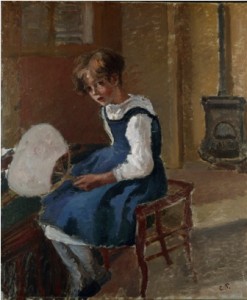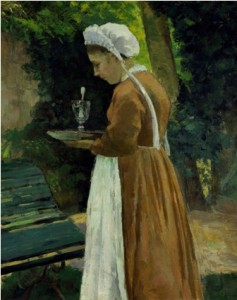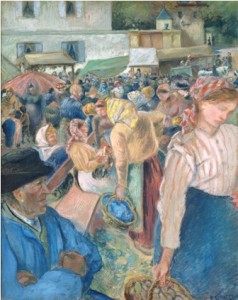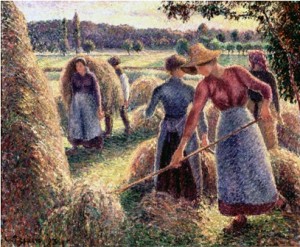[WILLIAMSTOWN, Mass.] – A poignant portrait of a little girl in a rose garden, a graceful trio of young women picking apples, and a gardener harvesting brilliant green cabbages are among the many marvelous paintings in Pissarro’s People, the fascinating exhibition of works by Impressionist painter Camille Pissarro (1830-1903), that opened Saturday and will be on view at the Sterling and Francine Clark Art Institute through October 2.
Pissarro’s People, curated by Richard R. Brettell, is the first major exhibition to explore the philosophy and political outlook of the painter relative to his portrayal of the human figure, in approximately forty p aintings and fifty works on paper.
aintings and fifty works on paper.
Pissarro’s People begins in the first floor Manton Gallery with an enormous black and white photograph of Pissarro and his family, sitting together out-of-doors, on a haystack. The image is emblematic of the show, which portrays the artist’s devotion and dedication to his family, his appreciation of and engagement with the agricultural community and rural life, and his philosophy of a better world to come, one where people were respected for the work they did, whether they were farmers or servants or artists.
Pissarro is called the father of Impressionism; he exhibited paintings in all eight Impressionist exhibitions. But he was an outsider, born to a Sephardic Jewish family in St. Thomas when  it was a colony of Denmark. Pissarro kept his Danish citizenship always, even though he lived most of his adult life in France. Pissarro married a non-Jewish woman and they had eight children; he was dedicated to his family. His politics and his philosophy were important as well: he was an idealist and an anarchist, believing that government and hierarchies are unnecessary and that all people are equal.
it was a colony of Denmark. Pissarro kept his Danish citizenship always, even though he lived most of his adult life in France. Pissarro married a non-Jewish woman and they had eight children; he was dedicated to his family. His politics and his philosophy were important as well: he was an idealist and an anarchist, believing that government and hierarchies are unnecessary and that all people are equal.
It is fascinating to know something about Pissarro’s life for the insight it provides into his artwork. But the paintings are glorious even without the back story. The distinctive brushstrokes, the vibrant and exciting palette, the composition and balance: the paintings are wonderful, in a way that can only be appreciated by seeing them in person.
 The exhibition continues in the second floor galleries with portraits of family and friends. The paintings of Pissarro’s wife and children show them reading, drawing, and sewing; useful occupations. The pictures are charming, tender, and evocative without being sentimental. One picture, Madame Pissarro Sewing beside a Window, shows the artist’s wife, with lovely pink cheeks and a pleated blue blouse, absorbed in her needlework, as a window with a decorative wrought iron balcony, visible on the left side of the canvas, allows a gentle swath of sunlight to fall across her hands.
The exhibition continues in the second floor galleries with portraits of family and friends. The paintings of Pissarro’s wife and children show them reading, drawing, and sewing; useful occupations. The pictures are charming, tender, and evocative without being sentimental. One picture, Madame Pissarro Sewing beside a Window, shows the artist’s wife, with lovely pink cheeks and a pleated blue blouse, absorbed in her needlework, as a window with a decorative wrought iron balcony, visible on the left side of the canvas, allows a gentle swath of sunlight to fall across her hands.
In another family member’s portrait, one of Pissarro’s daughters, Jeanne, called Cocotte, stops in her daily chores—she is still wearing  a ruffled apron—to read, sitting on a settee covered with an embellished red rug or tapestry; the painting is all luscious reds, pinks, and russet tones, and the book in the young woman’s hands is red, too. It’s an image of contentment, of comfort, not ostentation; and reveals the artist’s tender feelings for his subject. It’s a beautiful painting.
a ruffled apron—to read, sitting on a settee covered with an embellished red rug or tapestry; the painting is all luscious reds, pinks, and russet tones, and the book in the young woman’s hands is red, too. It’s an image of contentment, of comfort, not ostentation; and reveals the artist’s tender feelings for his subject. It’s a beautiful painting.
The show includes paintings in oil, tempera, and gouache; plus drawings and studies. The show builds in impact; beginning with domestic scenes and moving to genre paintings of domestic and farm workers and finally scenes of an idealized rural life with lively and colorful farmers’ markets.
 Pissarro’s paintings of the French countryside are vibrant and attractive, and the farm workers are shown with dignity; the same is true of Pissarro’s images of domestic servants. The rural workers are shown in light-flooded fields and orchards; Pissarro depicted the agricultural life as a desirable one.
Pissarro’s paintings of the French countryside are vibrant and attractive, and the farm workers are shown with dignity; the same is true of Pissarro’s images of domestic servants. The rural workers are shown in light-flooded fields and orchards; Pissarro depicted the agricultural life as a desirable one.
Apple-Picking, one of the largest paintings in the show, depicts three young women in an orchard harvesting apples; one is taking a bite of fruit while another looks up into the branches of the tree and the third girl gathers apples into a basket; the asymmetrical composition is emphasized by a pattern of blue shadows cast across the field and furrows. Pissarro’s farm scenes are idyllic, with delicately rendered foliage and vibrant produce; the colors are brilliant and delicious.
 The most overt expression of Pissarro’s political beliefs is seen in an album of drawings that he created for two of his nieces and titled Turpitudes sociales. The thirty images depict scenes of disgrace, hardship, or scandal, accompanied by handwritten text taken from anarchist literature. The album is on public view for the first time in this exhibition.
The most overt expression of Pissarro’s political beliefs is seen in an album of drawings that he created for two of his nieces and titled Turpitudes sociales. The thirty images depict scenes of disgrace, hardship, or scandal, accompanied by handwritten text taken from anarchist literature. The album is on public view for the first time in this exhibition.
The final gallery includes two of Pissarro’s self portraits, one painted just weeks before the end of his life, a haunting image. Pissarro’s People offers a unique and compelling look at life in the France of the Impressionists, through the eyes of an artist we come to know in a new way in this superb exhibition.
The Clark is at 225 South St. in Williamstown, Mass. The galleries are open Tuesday through Sunday, 10 a.m. to 5 p.m. (daily in July and August). Admission is $15, free for children 18 and younger, members, and students with valid ID. For more information, call 413.458.2303 or visit www.clarkart.edu.

